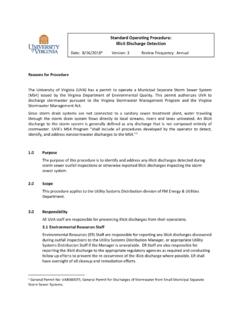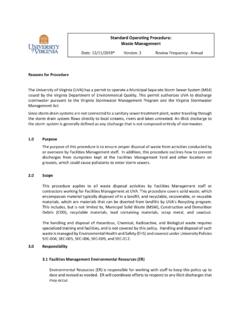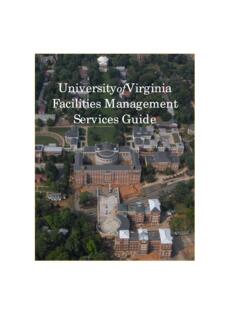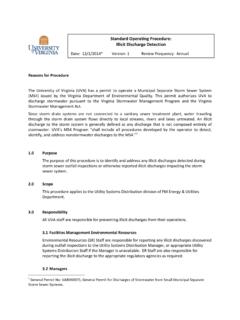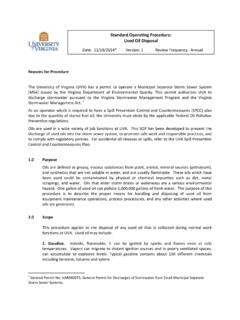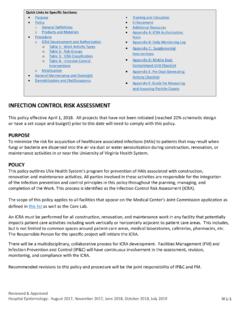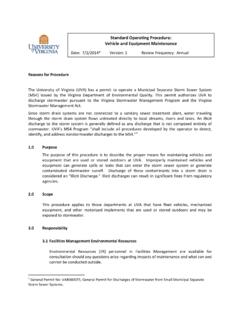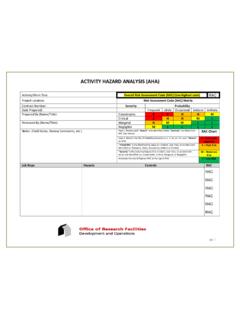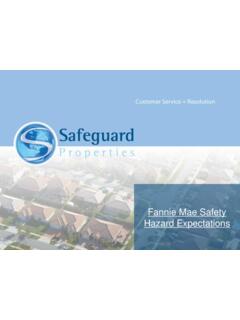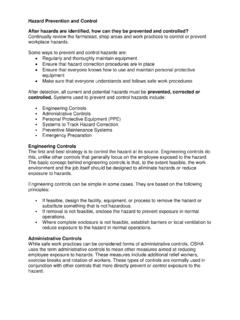Transcription of Job Hazard Analysis (JHA) - SAMPLE - University of Virginia
1 Job Hazard Analysis (JHA) - SAMPLE General Operation (Task): Digging Trench for Sprinkler Line Supervisor: Jon Smith Location: Lawn in front of Pav III Department/Unit: Landscaping Indoor Outdoor Your Name: Bob Jones PPE required: Gloves, Safety Glasses, Safety Shoes, high-vis Vest Reviewed by: Jim Shanahan Training required: Competent-Person Excavation, Equipment Training Equipment used: Mini-excavator with 24 bucket Chemicals used: Additional comments: Sequence of basic activity steps Break the activities into their basic steps. List their normal sequence of occurrence. Describe the what and the how of each step. Check with employees experienced with the activity Potential hazards or accidents Question each step for the potential causes of accidents. Seek ideas from observing similar work being performed and discuss with employees.
2 Recommend safe procedures For each potential Hazard , discuss what employees should do or not to do to avoid an accident. Be specific and brief. Use simple do and don t statements. Get ideas from observing work, and from discussions with employees. Never record useless generalities such as be careful , use caution , be alert , etc. Equipment to be used List equipment and machinery to be used in conducting the work for the activity. Inspection requirements List inspections that will be required of the equipment or machinery. Training requirements Determine Requirements for employee training, including Hazard communication to safely perform each basis step of the activity. Activity Potential hazards Procedures/Equipment/Training Trenching Hand/Foot Injury Construction boots are required. Inspect materials for sharp edges prior to handling.
3 Gloves are required when handling tools and materials Eye Injury Utilize safety glasses with side-shields. Underground Service Strike Miss-Utility will be called 48 hours prior to the beginning of work, to mark all underground utility locations. Trench collapse The depth of the trench shall be kept at 36 or less. A Competent Person in excavation shall evaluate the weather, soil, and work in progress to determine if a Hazard related to trench collapse is possible. Equipment Failure The Excavator with 24 bucket shall be inspected daily using the approved checklist. This inspection will be performed by trained operators, and a record will be kept onsite. Struck by Equipment All workers shall wear high visibility vests at all times. Trained operators shall maintain visibility of the work area, and the bucket swing radius.
4 Establish a designated path for excavator to minimize exposure to workers. Equipment Tip-over The excavator shall not drive on terrain un-level, as to where a tip-over is possible. The owner s manual shall be consulted for restrictions on terrain and the equipment. This responsibility lies with the trained operator. Fuel Spill Fuel shall be kept in OSHA approved cans. Fuel containers shall be properly labeled, if not already by the manufacturer. Trip hazards At the end of the day delineators and danger tape will identify open trench areas. The trench shall be backfilled as soon as possible. Site Access/Public Protection Public Protection The Work shall occur within a fenced and/or clearly delineated area. All visitors must sign in prior to entering site. Warning signs and postings reflecting sign-in and PPE requirements shall be placed in conspicuous areas at the entrance.
5
